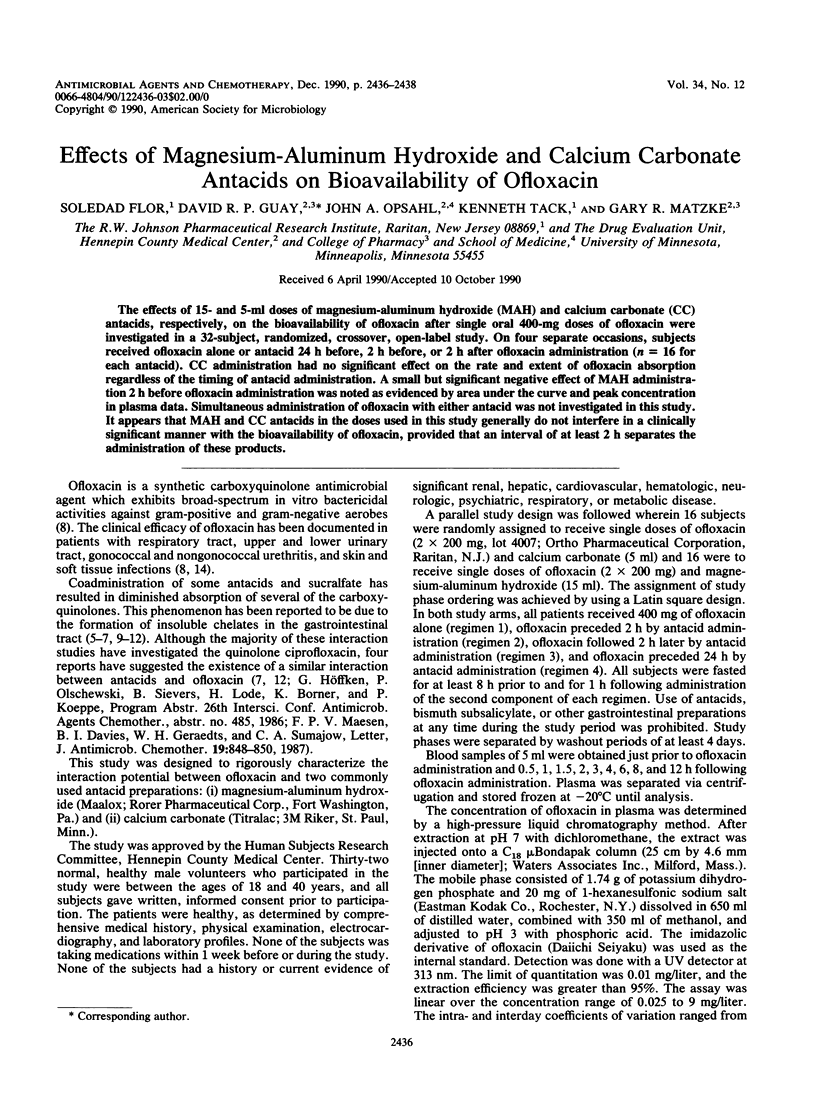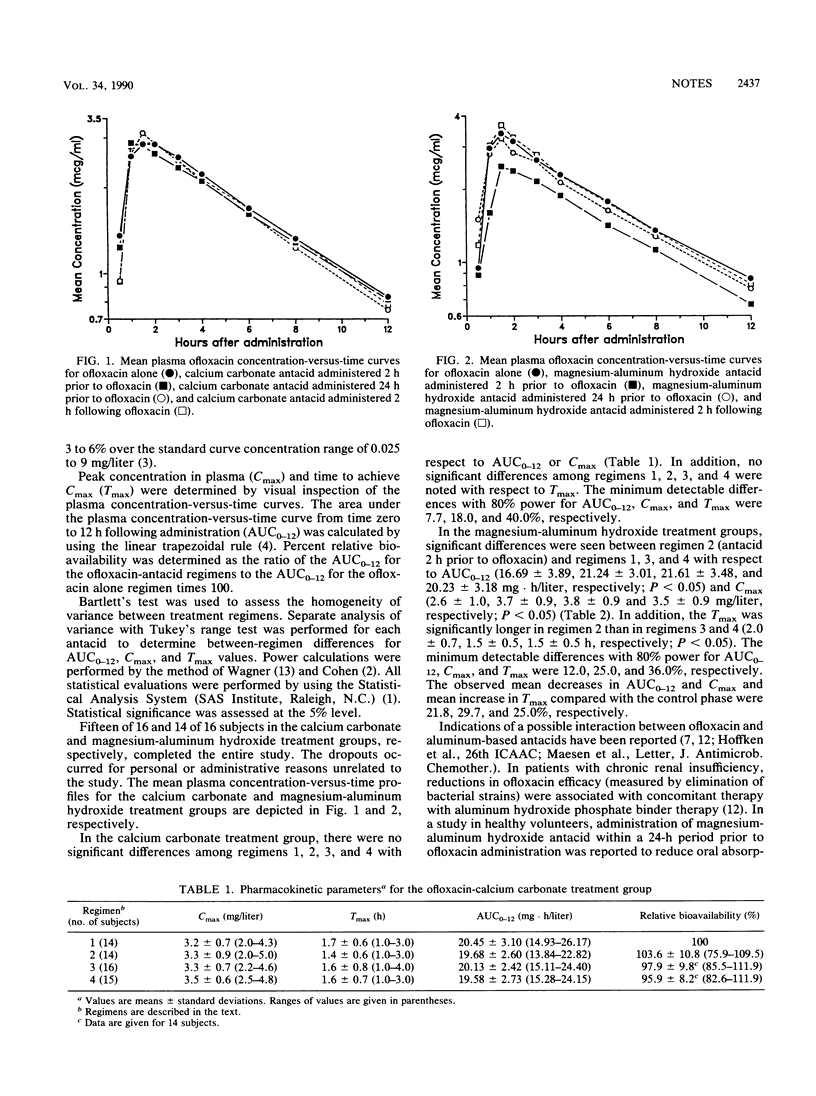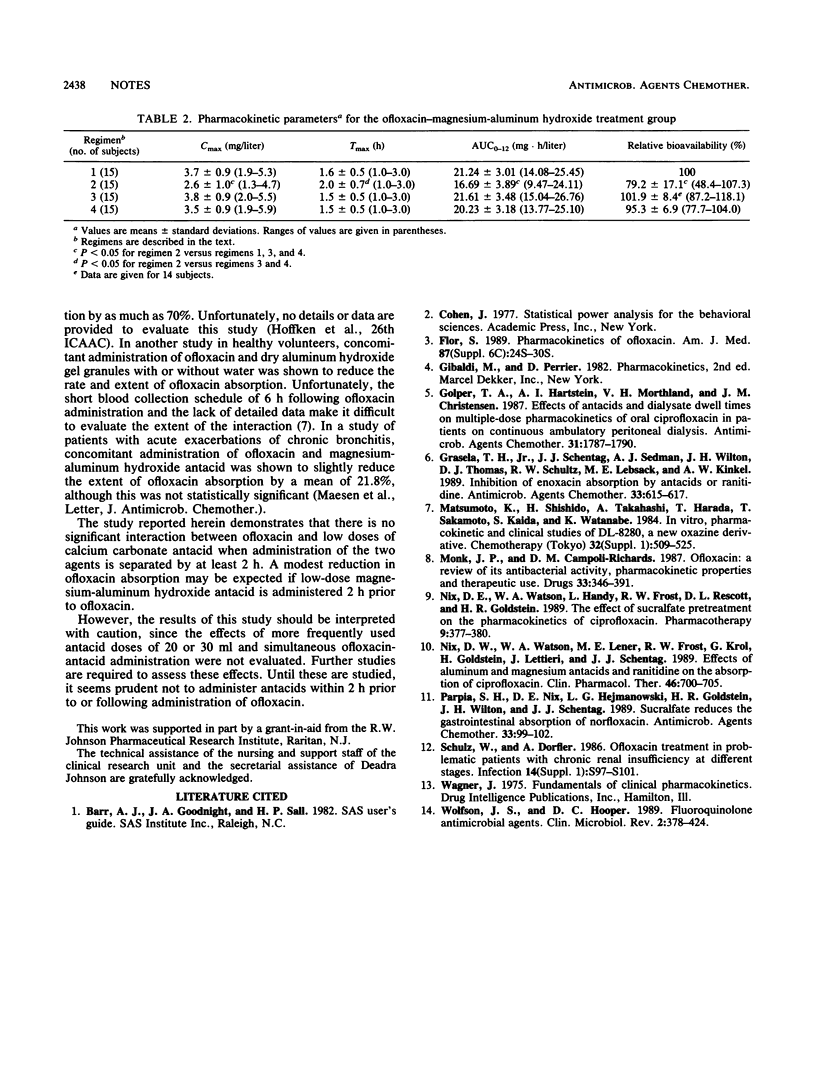Abstract
The effects of 15- and 5-ml doses of magnesium-aluminum hydroxide (MAH) and calcium carbonate (CC) antacids, respectively, on the bioavailability of ofloxacin after single oral 400-mg doses of ofloxacin were investigated in a 32-subject, randomized, crossover, open-label study. On four separate occasions, subjects received ofloxacin alone or antacid 24 h before, 2 h before, or 2 h after ofloxacin administration (n = 16 for each antacid). CC administration had no significant effect on the rate and extent of ofloxacin absorption regardless of the timing of antacid administration. A small but significant negative effect of MAH administration 2 h before ofloxacin administration was noted as evidenced by area under the curve and peak concentration in plasma data. Simultaneous administration of ofloxacin with either antacid was not investigated in this study. It appears that MAH and CC antacids in the doses used in this study generally do not interfere in a clinically significant manner with the bioavailability of ofloxacin, provided that an interval of at least 2 h separates the administration of these products.
Full text
PDF


Selected References
These references are in PubMed. This may not be the complete list of references from this article.
- Flor S. Pharmacokinetics of ofloxacin. An overview. Am J Med. 1989 Dec 29;87(6C):24S–30S. [PubMed] [Google Scholar]
- Golper T. A., Hartstein A. I., Morthland V. H., Christensen J. M. Effects of antacids and dialysate dwell times on multiple-dose pharmacokinetics of oral ciprofloxacin in patients on continuous ambulatory peritoneal dialysis. Antimicrob Agents Chemother. 1987 Nov;31(11):1787–1790. doi: 10.1128/aac.31.11.1787. [DOI] [PMC free article] [PubMed] [Google Scholar]
- Grasela T. H., Jr, Schentag J. J., Sedman A. J., Wilton J. H., Thomas D. J., Schultz R. W., Lebsack M. E., Kinkel A. W. Inhibition of enoxacin absorption by antacids or ranitidine. Antimicrob Agents Chemother. 1989 May;33(5):615–617. doi: 10.1128/aac.33.5.615. [DOI] [PMC free article] [PubMed] [Google Scholar]
- Monk J. P., Campoli-Richards D. M. Ofloxacin. A review of its antibacterial activity, pharmacokinetic properties and therapeutic use. Drugs. 1987 Apr;33(4):346–391. doi: 10.2165/00003495-198733040-00003. [DOI] [PubMed] [Google Scholar]
- Nix D. E., Watson W. A., Handy L., Frost R. W., Rescott D. L., Goldstein H. R. The effect of sucralfate pretreatment on the pharmacokinetics of ciprofloxacin. Pharmacotherapy. 1989;9(6):377–380. doi: 10.1002/j.1875-9114.1989.tb04152.x. [DOI] [PubMed] [Google Scholar]
- Nix D. E., Watson W. A., Lener M. E., Frost R. W., Krol G., Goldstein H., Lettieri J., Schentag J. J. Effects of aluminum and magnesium antacids and ranitidine on the absorption of ciprofloxacin. Clin Pharmacol Ther. 1989 Dec;46(6):700–705. doi: 10.1038/clpt.1989.207. [DOI] [PubMed] [Google Scholar]
- Parpia S. H., Nix D. E., Hejmanowski L. G., Goldstein H. R., Wilton J. H., Schentag J. J. Sucralfate reduces the gastrointestinal absorption of norfloxacin. Antimicrob Agents Chemother. 1989 Jan;33(1):99–102. doi: 10.1128/aac.33.1.99. [DOI] [PMC free article] [PubMed] [Google Scholar]
- Schulz W., Dörfler A. Ofloxacin-Behandlung bei nephrologischen Problempatienten mit unterschiedlich ausgeprägter chronischer Niereninsuffizienz (inkl. Dialyse-Behandlung). Vorläufige Ergebnisse. Infection. 1986;14 (Suppl 1):S97–101. doi: 10.1007/BF01645211. [DOI] [PubMed] [Google Scholar]
- Wolfson J. S., Hooper D. C. Fluoroquinolone antimicrobial agents. Clin Microbiol Rev. 1989 Oct;2(4):378–424. doi: 10.1128/cmr.2.4.378. [DOI] [PMC free article] [PubMed] [Google Scholar]


